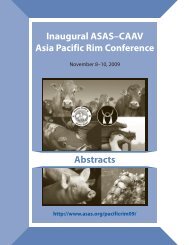PROCEEDINGS - American Society of Animal Science
PROCEEDINGS - American Society of Animal Science
PROCEEDINGS - American Society of Animal Science
Create successful ePaper yourself
Turn your PDF publications into a flip-book with our unique Google optimized e-Paper software.
NEg on a dry matter basis. The finisher ration was<br />
comprised <strong>of</strong> 10.76% CP, 5.53% CF, 4.03% fat, 1.81<br />
Mcal/kg NEm, and 1.15 Mcal/kg NEg on a dry matter<br />
basis. Average start and finish weights were collected. DMI<br />
data were collected during the test using the GrowSafe<br />
automated feeding system (GrowSafe Systems Ltd.,<br />
Airdrie, Alberta, Canada). A certified ultrasound technician<br />
using an Aloka 500 real-time unit equipped with a 3.5-MHz<br />
transducer collected all ultrasound data.<br />
Three different measures <strong>of</strong> feed efficiency were<br />
calculated for each animal. Feed conversion ratio (FCR)<br />
was determined as the ratio <strong>of</strong> DMI to ADG. Partial<br />
efficiency <strong>of</strong> growth (PEG) was computed as the ratio <strong>of</strong><br />
ADG to DMI for growth (Koch et al., 1963). RFI as defined<br />
by Koch et al. (1963) was calculated for each animal as the<br />
difference between actual intake and intake predicted by the<br />
stepwise linear regression used to determine the order <strong>of</strong><br />
inclusion <strong>of</strong> carcass characteristic and the significance <strong>of</strong><br />
trial to reach the final regression model <strong>of</strong> DMI on ADG,<br />
MMWT (BW 0.75 ), and uFT (Statistix9, 2008). Bulls were<br />
classified using RFI into low (0.5 SD; n=41; RFI=0.887 kg/d) groups (Basarab et al.,<br />
2003).<br />
Data were analyzed by ANOVA fitting RFI group<br />
as the independent variable (Statistix9, 2008). All pairwise<br />
comparisons were made using Tukey HSD (Statistix9,<br />
2008). Relationship between RFI and phenotypic<br />
performance traits and carcass traits were established using<br />
Pearson Correlation (Statistix9, 2008).<br />
Results and Discussion<br />
Favorable differences in FCR, PEG and daily<br />
intake were detected among RFI groups. Low (11.120 kg)<br />
RFI grouped bulls exhibited significantly reduced DMI<br />
compared to marginal (12.091 kg) and high (12.920 kg)<br />
RFI grouped bulls (Table 1). Significant differences in DMI<br />
were also detected among marginal and high RFI grouped<br />
animals (P=0.00). Lancaster et al. (2005) reported a 15%<br />
reduction in feed intake between low and high RFI bulls,<br />
despite no detection <strong>of</strong> differences in ADG and body<br />
weight. Similar trends existed for FCR. Low grouped bulls<br />
exhibited significantly lower FCR (5.74 kg; P=0.00)<br />
relative to marginal (6.43 kg) and high (6.94 kg) grouped<br />
bulls. Favorable group differences were apparent for PEG.<br />
Low RFI bulls had higher PEG (0.493; P=0.00) than high<br />
RFI bulls (0.320). Marginal RFI bulls also had significantly<br />
higher PEG (0.380; P=0.00) than high RFI bulls. No<br />
significant group differences were detected in on-test<br />
weight, <strong>of</strong>f-test weight, or ADG indicating that selecting for<br />
reduced RFI may result in improved feed efficiency with<br />
minimal impact on growth (Table 1). Residual feed intake<br />
has been shown to be genetically and phenotypically<br />
independent <strong>of</strong> its component traits (Arthur et al., 2001).<br />
This finding indicates that changes to component traits will<br />
not likely result from selection based upon improved RFI.<br />
Analyses <strong>of</strong> group means for phenotypic carcass<br />
characteristics are included in Table 2. No significant group<br />
differences were detected in uREA, uFT, or uPIMF.<br />
Comparisons made were consistent with the findings <strong>of</strong><br />
Cardin et al. (2008), indicating low RFI grouped bulls had<br />
numerically lower uFT. Robinson and Oddy (2004)<br />
suggested that selection for reduced RFI would likely result<br />
in decreased subcutaneous fat. Additionally, bulls did not<br />
differ based upon RFI group in ultrasound carcass trait<br />
EPDs (Table 3). Lancaster et al. (2008) noted that RFI has<br />
been weakly correlated with twelfth rib fat thickness. As<br />
expected, accounting for body composition in the<br />
regression model removed these differences. Basarab et al.<br />
(2003) reported that including body composition in the<br />
model to determine RFI accounted for more variation in<br />
DMI. Lancaster et al. (2009) reported that adjusting RFI for<br />
carcass composition only minimally impacts animal ranking<br />
in growing animals when compared to using only MMWT<br />
and ADG, yet in finishing animals, the relationship between<br />
body composition and RFI is stronger suggesting it may be<br />
favorable to include body composition in the regression<br />
model to calculate RFI.<br />
Phenotypic correlation indicated that RFI<br />
was significantly and favorably correlated with FCR (0.490;<br />
P=0.00), a finding corroborated by numerous investigations<br />
(Jensen et al., 1992; Herd and Bishop, 2000; Hoque et al.,<br />
2005; Hoque et al., 2006; Cardin et al., 2008). RFI was also<br />
significantly correlated with PEG (-0.898; P=0.00),<br />
indicating that selection for reduced RFI would likely result<br />
in increased PEG. Lancaster et al. (2005) reported similar<br />
findings when RFI was correlated with PEG (-0.85),<br />
indicating bulls with low RFI had higher PEG than both<br />
marginal and high RFI bulls. RFI was significantly<br />
correlated with dry matter intake (0.702; P=0.00). Hoque et<br />
al. (2006) and Arthur et al. (2001) reported correlation<br />
values <strong>of</strong> 0.72 and 0.69, respectively, for RFI and DMI.<br />
Furthermore, Carstens et al. (2002) and Nkrumah et al.<br />
(2004) reported that RFI was significantly correlated with<br />
ultrasound back fat (0.22 and 0.19 respectively; P
















